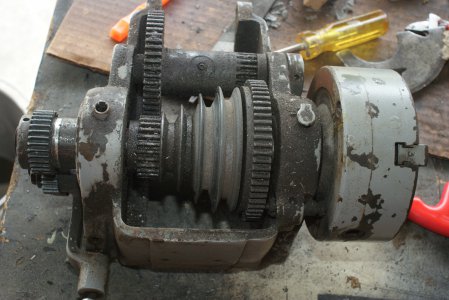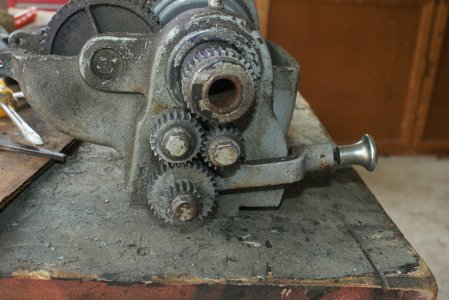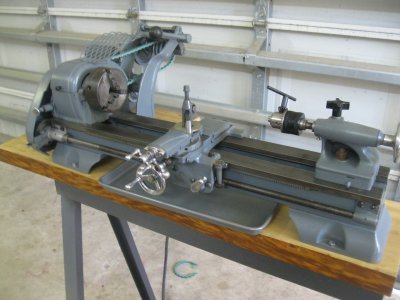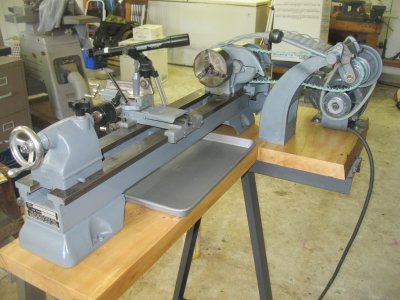-
Welcome back Guest! Did you know you can mentor other members here at H-M? If not, please check out our Relaunch of Hobby Machinist Mentoring Program!
You are using an out of date browser. It may not display this or other websites correctly.
You should upgrade or use an alternative browser.
You should upgrade or use an alternative browser.
Logan 200??? Or ???
- Thread starter bama7
- Start date
These old machines force you to learn about the machine as much as machining, if you enjoy that part of the challenge, it's a no brainer. Just be aware that while taking it on can be rewarding, it will likely be frustrating at times too. But lots of resources these days, you are not alone.
My first personal lathe was a basket-case Logan 200, but all the effort to fix and repair, and learning the machine, was well worth it for me.
My first personal lathe was a basket-case Logan 200, but all the effort to fix and repair, and learning the machine, was well worth it for me.
- Joined
- Jun 29, 2014
- Messages
- 197
I got a Craftsman version of the Atlas 618 a couple of years ago. I stripped it down got new parts, and old parts, removed all the rust, and painted it and put it on a very nice piece of wood attached to the metal frame it came with, a school lathe. I really enjoyed working on it, but it was a little disappointing when trying to use it. Not really the lathes problem, but more me.








I am with you on which one I would rather have. Do you know if it should have the "peg leg" for the motor?
If the motor is mounted in a similar way to the Logan 200, then it most likely will need a "peg-leg".
However a length of steel pipe works perfectly as illustrated in post #69 of Mbfrontier's "Logan 200 Rehab" http://www.hobby-machinist.com/threads/mbfrontiers-logan-200-rehab.33219/page-4
- Joined
- Dec 25, 2011
- Messages
- 10,511
To answer the peg leg question, I have copies of four Wards catalogs between 1941 and 1950. Peg legs are shown on the Logan branded models if they shipped with drip pan and cast iron legs. And not shown on the bench models. The cabinet model is indeterminate as you can't see behind it, and the text no where mentions the peg legs anyway. The Wards models shown on drip pan and legs do not show a peg leg. And as previously mentioned, do not show a belt cover. However, there would be nothing stopping you from adding the Logan peg leg.
Fortunately, the one that you are looking at has ball bearings. In 1941, Wards offered a sleeve bearing model without power cross feed. It isn't mentioned in 1943 and later. So is probably pretty rare.
The Craftsman 101.21400 that you rebuilt looks very nice. However, the motor is on backwards. It should be up under the countershaft bracket, a somewhat more stable location. The left (visible) legs are really too small. Should probably be about 2 x 3 instead of what looks like 1 x 1. That would stiffen it up a bit. Link belts are generally a bad idea except in an emergency (which is what they were made for). And finally, the lathe will work much better with either a 4-way turret tool holder or a QCTP. The lantern is just too flexible.
Fortunately, the one that you are looking at has ball bearings. In 1941, Wards offered a sleeve bearing model without power cross feed. It isn't mentioned in 1943 and later. So is probably pretty rare.
The Craftsman 101.21400 that you rebuilt looks very nice. However, the motor is on backwards. It should be up under the countershaft bracket, a somewhat more stable location. The left (visible) legs are really too small. Should probably be about 2 x 3 instead of what looks like 1 x 1. That would stiffen it up a bit. Link belts are generally a bad idea except in an emergency (which is what they were made for). And finally, the lathe will work much better with either a 4-way turret tool holder or a QCTP. The lantern is just too flexible.
- Joined
- Jun 29, 2014
- Messages
- 197
Thank you for that info. If I read the chart correctly the serial number 5876 was a 1943 model. Good info on the ball bearings! I enjoyed working on the 214 and making it "pretty" again. The lathe came from a school in Broward County and was setup on the metal frame as shown, except for the wood base. Many of these 214's I read about used the link belts claiming they gave better grip and of course easy of changing them. I knew as I was reworking the 214 I would not keep it for long. I did get a QCTP for it and it went with the lathe when it was sold. That was a good project.To answer the peg leg question, I have copies of four Wards catalogs between 1941 and 1950. Peg legs are shown on the Logan branded models if they shipped with drip pan and cast iron legs. And not shown on the bench models. The cabinet model is indeterminate as you can't see behind it, and the text no where mentions the peg legs anyway. The Wards models shown on drip pan and legs do not show a peg leg. And as previously mentioned, do not show a belt cover. However, there would be nothing stopping you from adding the Logan peg leg.
Fortunately, the one that you are looking at has ball bearings. In 1941, Wards offered a sleeve bearing model without power cross feed. It isn't mentioned in 1943 and later. So is probably pretty rare.
The Craftsman 101.21400 that you rebuilt looks very nice. However, the motor is on backwards. It should be up under the countershaft bracket, a somewhat more stable location. The left (visible) legs are really too small. Should probably be about 2 x 3 instead of what looks like 1 x 1. That would stiffen it up a bit. Link belts are generally a bad idea except in an emergency (which is what they were made for). And finally, the lathe will work much better with either a 4-way turret tool holder or a QCTP. The lantern is just too flexible.
- Joined
- Jun 29, 2014
- Messages
- 197
Got it home yesterday and I now have it taken apart for cleaning and inspection. The ways look really good and everything seems to move well. Once I get all the crud out of the way and everything lubed it should be very smooth, please, please, please. It took some creativity to get it out of my truck. I thought for awhile I would need to start a mobile machine shop.
- Joined
- Jun 22, 2015
- Messages
- 68
I bought my Logan pretty cheap. It had gears for the almost the slowest feed.... Which if I never wanted to threading would be appropriate. I bought a set of gears on ebay for $200 and the Lath cost me $500. I have a lot of elbow grease in the lathe but mot much else past the $700 total.
I agree with what others have said, the asking price needs to reflect the fact that the gears are missing.
I agree with what others have said, the asking price needs to reflect the fact that the gears are missing.


